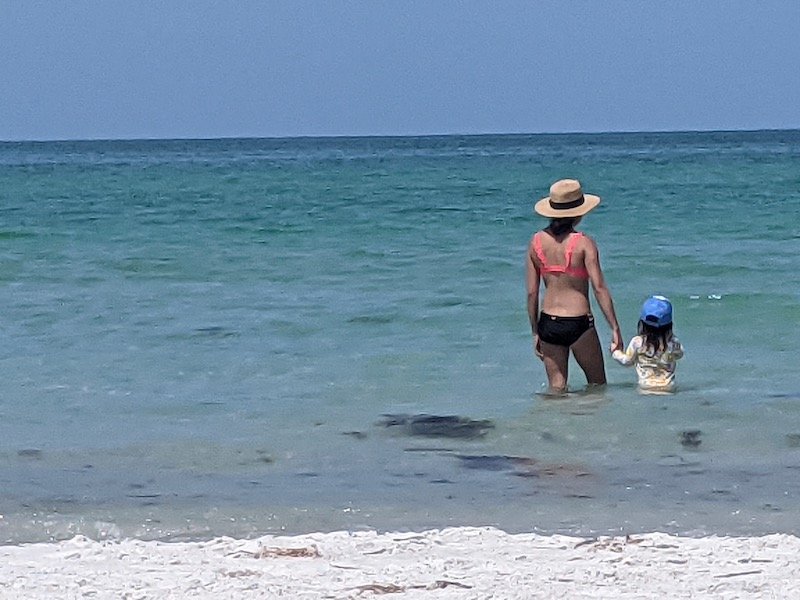Take note though…this post is about reasons to LIMIT the use of sunscreen. It’s a wonderful invention and can be a great way to take proactive care of your body. So while some of us might be getting closer to the mindset of, “EVERYTHING IS POISIN! THROW IT ALL AWAY! UNLESS I MAKE IT FROM SCRATCH IT’S TRASH!”… including myself, I would caution us to not throw the baby out with the bathwater. While there certainly are toxic ingredients infesting everyday consumer products, there are fortunately, more clean ingredient options than ever before and we as consumers (for better or worse) have more easy to access information than ever before to hopefully empower (not overwhelm) our decision making process.

“Too much of a good thing…”
we’re all familiar with this age-old quote.
I just used this saying the other day when chatting with my husband about the value of alone time…and then when speaking with my daughter about her fantasy of eating chocolate all day every day.
But I bet most of us haven’t thought about this phrase in relation to sunscreen. I’m sure we’ve all thought about the dangers of too much sun exposure, but not necessarily too much protection FROM the sun.
I mean, is that even a thing?
Well, our family has recently lowered our dependency on sunblock as I have been unlearning and re-learning the value of natural sunlight, the true dangers (and lack thereof) of sun exposure and the hidden toxins found in sunscreen, both chemical and mineral.
It was really hard for me to let go. As an adolescent and young adult I was all about oil baking in the sun to get that summery bronze glow. I have a more medium complexion and it requires a fair amount of effort on my part to get a sunburn. So, I rarely felt inclined to use an SPF higher than 8 when at the beach, pool, or just being outside in general. More often, I’d reach for the tanning oil! I loved the coconutty, summery smell and the golden glow that came with it.
Well, after I grew out of my ignorant, invincible, image is everything young adult phase and grew a tad bit wiser and aware of the dangers these habits would lead to, I swung to the other side of the spectrum (especially after having kids). Sunblock all the time, everywhere. If it leaves a white haze making us look like we’re somewhere between human and undead…even better.
But here’s the thing. The majority of messaging we receive in regards to the sun is that of fear. If we don’t coat our bodies head to toe in sunblock, especially during the warmer months, we are putting ourselves at risk for wrinkles and the big “c” word. So while I took a hard swing from one side of the spectrum to the other, I realized I had swung too far.
While sunscreen certainly has its benefits, especially when you are going to have long periods of direct sun exposure with little to no shade availability, research seems to be pointing towards the fact that it has become an overused staple and is one of the leading causes of vitamin D deficiency.
Why is Natural Sunlight Exposure So Important?
- It is one of the best sources for vitamin D. Here is one of many articles that discusses sun exposure as the main link to the vitamin D deficiency epidemic. https://pubmed.ncbi.nlm.nih.gov/16251641/#:~:text=Abstract,for%20both%20children%20and%20adults.
In the early 1800’s Jędrzej Śniadecki concluded that the development and outbreak of rickets in children in Northern Europe was related to their lack of sun exposure. Post industrial revolution, city buildings were built in very close proximity resulting in a much higher incident rate among inner city children versus those who lived in rural areas. Seventy years later, Theobald A. Palm arrived at the same conclusion based on research done in third world countries such as India and China where rickets was uncommon compared to the high prevalence found in children living in London. In 1921, Alfred Hess and Lester Unger discovered a significant improvement in rachitic children exposed to sunlight on the roof of their New York City hospital. In addition, skeletal biologist Simon Mays, found a connection between rickets and vitamin D deficiency in skeletal remains found in Rome, home of the first period of widespread urban development. He found signs of rickets in more than 1 in 20 children after examining some 2,787 skeletons from 18 different 1st to 6th century Roman cemeteries. Higher occurrence of this disease has also been found in Ostia, one of Rome’s major ports on the Tiber river. This city would have been densely populated and contain a higher concentration and frequency of tall apartment buildings among narrow streets.
While we can obtain this vitamin by eating certain foods, we often don’t eat enough of them and/or these specific foods are not reliable sources of vitamin D. The food we eat today has often been depleted of vital nutrients due to modern farming and the time it takes to transport them to the shelves of your local grocery stores. The more you are able to shop through local farms and farmers markets, the better, since they will be fresher and thus have a higher nutrient content. - It helps set our body’s circadian rhythm. When waking up in the morning, try not to look at your phone first thing. The blue light can actually have the opposite effect in balancing our internal clock. Let your eyes soak in natural light first. Our quality of sleep can greatly affect energy levels, weight gain, hormone levels and blood sugar balance.
- It puts you in a better mood. Sunlight helps to boost your serotonin levels. Serotonin is a chemical produced by the brain and is known as one of the “happy hormones”. Supporting serotonin production can help our energy levels and our emotional well-being.
- It can help lower blood pressure. Exposure to sunlight helps trigger the skin to release stores of nitrogen oxides which cause arteries to dilate, thus lowering blood pressure.
- Helps heal inflammation. Sun exposure has actually been used to help fight chronic inflammatory conditions such as heart disease, psoriasis, asthma, acne and even some forms of cancer.
- It can help balance blood sugar. Two studies out of the University of Edinburgh and Northwestern University suggest that sun exposure can help prevent diabetes and actually slow weight gain. The test subjects showed less warning signs of diabetes and lower BMIs.
- Helps to support a strong immune system. Vitamin D is essential for our body to be able to fight off pathogens. It also helps to tell our immune systems to turn off its inflammatory response when the fighting is done. It’s an important immune system regulator.

The sun is one giant, free medicine we all have access to and a powerful support for our biological systems. And yet we’ve been lured into having an irrational fear of it, and a false sense of comfort in sunscreen. Interestingly, although SPF use is higher now than ever before, the number of melanoma cases continue to rise (as discussed in the article here https://www.jabfm.org/content/24/6/735)! Shouldn’t the opposite be the case? There’s actually very little evidence that sunscreen protects against cutaneous malignant melanoma. It also interferes with the body’s melanin production, our body’s best protection against sunburn. Melanin not only protects our bodies from harmful UV rays and blue light but it helps to protect the genetic material stored in our cells. It is a super powerful antioxidant that has been linked to lowered inflammation, cellular oxidation protection and an increased tolerance of infrared.
How to Proactively Protect Your Skin Without Sunscreen
Things To Do:
So, best advice is to go outside and bake in the sun unprotected for as long as possible?
Definitely not! Letting your skin fry and burn to a crisp is not the answer. But, there are a number of ways you can give your body a healthy dose of natural sun exposure in a smart, non-toxic way.
- Take advantage of the morning light. The sun’s rays are less powerful in the early hours so for those with more sensitive skin, it’s a great way to get in some SPF-free sunlight exposure. In addition, exposing your eyes to sunlight first thing in the morning, before a cell phone or TV or computer, helps improve mood, regulate your circadian rhythm and regulate blood sugar levels for the day.
- Gradually build up your exposure. Allow the sun to touch your unprotected skin on and off throughout the day on a regular basis. This can be especially helpful to do during the spring months in order to create a natural melanin barrier prior to the intense rays of the summer months.
- Go easy on the sunglasses. As mentioned in number one, exposing the naked eye to natural sunlight has many benefits. There are hormones produced by way of the pineal gland that stimulate a number of metabolic processes including melanin production. When we wear sunglasses, it signals to our bodies that it is dark outside, thus effecting their ability to produce melanin.
- Use the shade before sunscreen. If shade is available, opt for giving your skin a break from the sun in lieu of lathering on the SPF.
- Take a closer look at your diet. Things like seed oils (high in PUFA or polyunsaturated fat), processed sugar and alcohol are known to increase oxidative stress and thus inflammation and can exacerbate your skins reaction to the sun’s UV rays.
- Eat your sunscreen! Yep, you read that correctly! By incorporating foods that have natural sun protecting compounds int your diet, you can actually increase your body’s ability to protect itself against harmful rays. These include:
- Red, pink and orange colored fruits & veggies (tomatoes, watermelon, carrots) which contain lycopene
- Olive oil contains a powerful antioxidant called squalene
- Egg yolk for its zeaxanthin another powerful antioxidant
- Green tea contains UV protecting polyphenols
- Raw butter, ghee and coconut oil or other whole foods with saturated fat which combat oxidative stress and help the body’s anti-inflammatory response
- Salmon which is rich in omega-3 content
Ingredients to Avoid When Buying Sunscreen
Sunscreen certainly has its time and place. My family and I vacationed on the west coast of Florida last summer and we spent many days camped out on the beach in the intense Florida June sun. We used umbrellas for shade but seeing as how our kids turn into fish when it comes to ocean swimming, we used sunscreen on days when we knew we’d be on the beach and out of the shade for extended periods of time.
Sunscreen isn’t the devil, just like the sun isn’t out to destroy us. However, label reading is KEY when it comes to shopping for sunscreen. Chemical sunscreens often times do more harm than good. They contain neurotoxic, hormone disrupting chemicals as their main ingredients and can actually increase our risk of cancer, ironically enough. Some main ingredients to look out for and steer clear of include:
- Oxybenzone
- Octinoxate
- Homosalte
- Octisalate
- Octocrylene
- Avobenzone
Mineral based sunscreens, while certainly not perfect, offer a much safer and low-tox means for topical sun protection when the situation calls for it. More on this to come including my favorite sunscreens for our whole family.
It’s a huge topic my friends. And while technical, scientific writing isn’t really “my thing”, I think it’s so important to understand the “why” and not just throw heavy claims and personal recommendations around willy-nilly. And as always, my mission in all of this…this post…this whole blog…is never to invoke a sense of fear or paralysis induced by overwhelm. It’s always to arm you with empowering knowledge that will open the door to options. To make confident choices as you piece together what health and wellness will look like for you and your family.




Leave a Reply